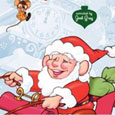Melendez/Mendelson Productions (1991), Warner Home Video (April 7, 2009), 1 disc, 23 mins plus supplements, 1.33:1 original full frame ratio, Dolby Digital 1.0 Mono, Not Rated, Retail: $19.98
Storyboard:
Snoopy is born at the Daisy Hill Puppy Farm, where he enjoys playing music with his doggie siblings. They all eventually get sold, and Snoopy ends up with a certain round-headed kid. Four years later, in an effort to cheer up Snoopy, Charlie Brown stages a family gathering that reunites Snoopy with his brothers and sisters.
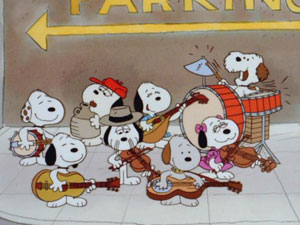
The Sweatbox Review:
Snoopy Come Home was a 1972 film that many remember as the best of the Peanuts theatricals. Its potent mix of sentimentality and poignancy make it a tearjerker fondly remembered by many, mostly from its television airings, since it was actually a bit of a flop on its theatrical release. The story concerned Snoopy’s reunion with his original owner Lila, who he goes to visit in the hospital. Charlie Brown learns for the first time that someone else owned Snoopy, and it appears for a while that Snoopy is set to return to live with Lila. Obviously, Snoopy does end up back with Charlie Brown, but not before emotions are laid bare and tears are shed.
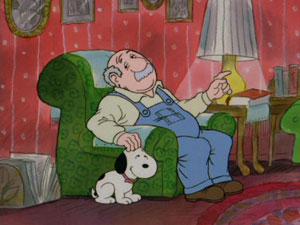
The television special Snoopy’s Reunion fleshed out the origins of Snoopy further in 1991. The 1972 movie in some ways had adhered more closely to the comic strip continuity of the 1960s (where Lila had been mentioned a few times before finally appearing in 1968), but the TV special does goes further in showing what transpired at Daisy Hill in Snoopy’s early days. This is quite a unique special, in that it starts out with an extended flashback, set a few years earlier than the present day, just after a dog named Missy has given birth to a litter of eight puppies at Daisy Hill Puppy Farm. The special is also unusual in that it portrays human adults, including the owner of Daisy Hill, complete with real speech instead of the trombone voices of previous specials.
The pups get along from the start, and quickly take to playing a variety of musical instruments, forming a type of canine country band. This familial bliss is short-lived, however, as the farmer soon puts up a “Puppies For Sale” sign. Meanwhile, we meet Charlie Brown, dejected after yet another baseball loss. He tells his sister Sally that he wishes he had a dog to come home to, as that would make bad days seem so much better. At Daisy Hill, the puppies are going one by one, and the sounds of the family band get thinner and thinner as the band is deprived of its members. Snoopy goes to Lila, and in the end only Missy remains with the farmer.

Lila loves Snoopy very much, and they have great times together, but she must return him to the farm once her apartment building goes dog free. This leaves an opportunity for Charlie Brown to buy him, which he does on a trip he takes with Linus to the farm. Of course, it turns out that Snoopy is a very special dog, who immediately seems more capable than his new owner, and shows a preference to sleep on the top of his doghouse. After nearly four years, however, Snoopy begins to show signs of loneliness. Sally and Charlie figure out that he is missing his family, and they invite all of Snoopy’s siblings for a reunion. The plan is to go back to Daisy Hill Puppy Farm, but what they find there is far from nostalgic. Still, even if progress has eliminated a farm on the outskirts of the city, the true purpose of the reunion is fulfilled. Snoopy and his siblings form the old band again, and have a great time playing music and spending time together.
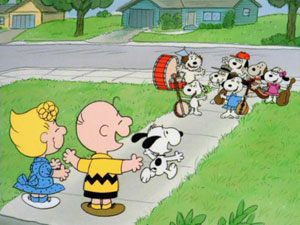
Okay, I kind of committed the reviewer’s sin of explaining the whole plot; but this is such a simple story it’s hard not to sum it all up. I did leave out a couple of surprises, though. Those surprises help to keep the viewer from falling totally to sleep, because this is one leisurely paced cartoon. That seems somewhat appropriate, given the rural setting that the first half of the story has, but I could have used a little more substance. The extensive farm sequence functions as a prolonged flashback that could have been summed up in about a minute, dragging out the introduction of Snoopy’s brothers and sisters while providing nothing more to the plot. And when Charlie Brown issues invitations to the family members, it wasn’t really necessary to see each one receive it in the mail. The general story was a nice idea, but the script needed to be a few pages longer to make it worthwhile. Still, it has some sweet sentiments in it.
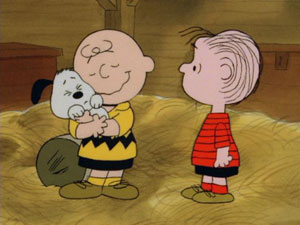
It may be noted that Snoopy’s Reunion does fool with continuity. While Snoopy Come Home generally stuck with what was shown in the strip, Snoopy’s Reunion fiddles with previously known facts. No longer is Snoopy a gift from Charlie Brown’s parents. And now Sally is present already when Snoopy is brought home, instead of being born later. It also essentially writes Snoopy Come Home out of continuity by showing Charlie Brown finding out about Snoopy’s first owner almost immediately. These niggling details, and the presence of adults, make this special seem out of touch with the others; but it is still neat in a fan-ish way to see Snoopy with his brothers and sisters. I won’t revisit this special nearly as much as some others, but it’s a nice one to watch at least once, anyhow.
Is This Thing Loaded?
The featurette this time around is Together Again: A Peanuts Voice Cast Reunion (9:50). I was excited to see this, actually, because it was produced from footage taken at the San Diego Comic-Con in 2008, where I had personally attended the cast reunion panel. There were some nice anecdotes from the panel, but the panel itself is barely seen here. Instead, we get fairly trivial interviews with Lee Mendelson and the panel participants, from interviews done inside or outside the San Diego Convention Center. They had so much more to say in the panel, it’s a shame that all we see here are superficial comments about how nice it is to see each other again, etc. A lost opportunity.
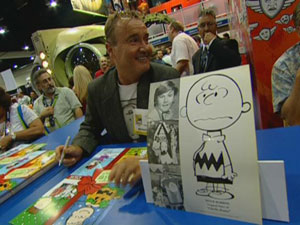
The bonus cartoon for this disc is the TV special It’s Flashbeagle, Charlie Brown (24:21). Oooooh, boy. Watching this, one can pretty much guess its 1984 vintage. It was beyond dated about two minutes after it premiered. Based on the energetic dance craze epitomized by the movie Flashdance, we see Snoopy in leggings and a headband, bopping around to bad 80s music. Fortunately, there is more to the special than that, as we also see segments devoted to Peppermint Patty’s tribulations at school, Snoopy at Sally’s show and tell, a number of peppy character songs (to which everyone dances), and the kids going to a disco… okay, most of this one’s a write-off (except the Peppermint Patty stuff). BUT it is fun to watch if you can set your brain on “kitsch” mode. The plot is all over the place, and it’s mostly retro-campy now, but one can’t look away, no matter how hard one tries.
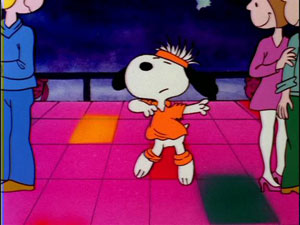
There are also Promos for more Peanuts DVDs, as well as one for Sesame Street Presents Follow That Bird.
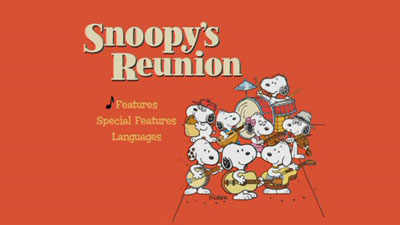
Case Study:
Warner stays consistent, with a standard keepcase inside an embossed foil o-sleeve. No inserts. The cover color this time is darker than usual, so this time the orange is not too gaudy.
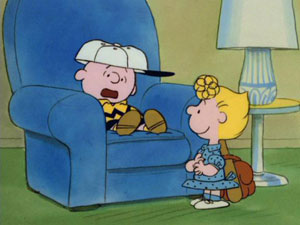
Ink And Paint:
The video quality on the main feature is pretty good, but not perfect. There are still a few specks that appear, as well as occasional quivers in the image during pans, but it’s a relatively clean and clear presentation. Flashbeagle, however, doesn’t look restored at all. The picture is grainy at times, and even noisy; but colors appear accurate, at least.
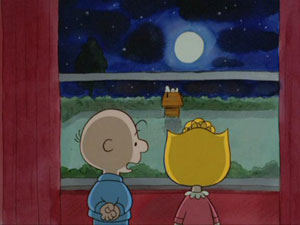
Scratch Tracks:
Oddly, the mono sound is presented via two channels on the main feature, and just one channel on the bonus cartoon. Not that it makes much of a difference. Either way, the sound is distinctly nondescript. Snoopy’s Reunion is adequate, while Flashbeagle sounded a little garish— but maybe it was just the effect the awful Eighties music had on me. There is also a Japanese mono track. Subtitles are available in English, French, Thai, Japanese, and Korean.
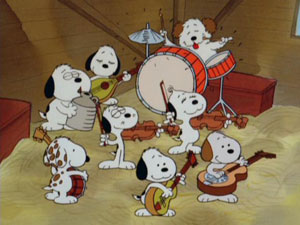
Judy Munsen did okay with the music for the main feature on this disc, but the repeating country music got tiresome pretty quickly (particularly since I don’t care for country music, especially the jug band variety). Then we go to Flashbeagle… not good. That special was certainly a product of its time, but I’ve never missed Vince Guaraldi as much as I did while watching this disc.
Final Cut:
Two mediocre TV specials in one package! Ho-hum.
Okay, at this point Warner really needs to start getting serious about packaging more specials at a time. I know that we have a 1960s compilation coming, and I do hope that they follow through with some 1970s volumes before going to the well again with these single-disc releases. I’m always glad to see more Peanuts on DVD, but my dwindling shelf space demands that I start seeing more bang for the buck, particularly with too many of these specials now falling into the “average or below” category.
 | ||
 |









